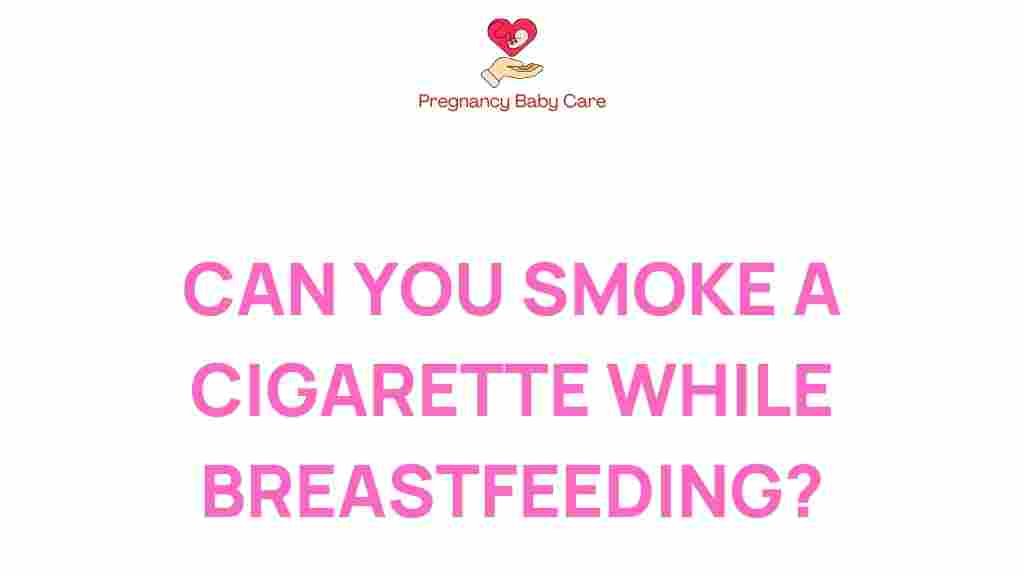The Surprising Truth About Smoking and Breastfeeding
Smoking is a well-documented health hazard that poses serious risks to both maternal health and infant safety. When it comes to breastfeeding, many new mothers may wonder about the effects of smoking on their ability to provide safe, healthy nutrition to their babies. This article explores the complex relationship between smoking, breastfeeding, and health risks, shedding light on nicotine exposure, maternal habits, and guidelines for breastfeeding mothers.
Understanding the Risks of Smoking During Breastfeeding
Smoking can have detrimental effects on maternal health and can also affect the infant through breast milk. The key health risks associated with smoking during breastfeeding include:
- Nicotine Exposure: Nicotine can transfer into breast milk, and infants can be exposed to this harmful substance during feeding.
- Reduced Milk Production: Smoking may lead to lower milk supply, affecting the nutritional intake of the infant.
- Increased Risk of SIDS: Studies indicate a higher risk of Sudden Infant Death Syndrome (SIDS) in infants whose mothers smoke.
- Respiratory Problems: Babies of smoking mothers are at greater risk of developing respiratory issues, including asthma and bronchitis.
- Increased Illness: Infants may experience more frequent illnesses due to compromised immune systems from maternal smoking.
Maternal Health and Smoking
For mothers, smoking has numerous health risks that can affect not just their own well-being but also the health of their infants. Some of the key maternal health issues linked with smoking include:
- Cardiovascular Issues: Smoking increases the risk of heart disease, which is a major health concern for new mothers.
- Hormonal Imbalances: The chemicals in cigarettes can disrupt hormonal levels, which can affect breastfeeding.
- Increased Stress: Maternal habits like smoking can lead to higher stress levels, which can negatively impact both breastfeeding and overall health.
Infant Safety and Smoking
Infant safety is paramount, and smoking poses significant risks. The effects of smoking on infants can be severe and long-lasting. Here are some important considerations regarding infant safety:
- Increased Vulnerability: Infants are more susceptible to the harmful effects of nicotine and other chemicals found in cigarettes.
- Environmental Smoke: Secondhand smoke exposure can lead to respiratory problems and other health issues in infants.
- Long-term Developmental Issues: Infants exposed to smoking may face long-term developmental challenges, including cognitive and behavioral issues.
Breastfeeding Guidelines for Smoking Mothers
For mothers who smoke, it is crucial to follow certain guidelines to minimize the risks associated with smoking and breastfeeding:
- Timing is Key: If you smoke, try to time your smoking to minimize nicotine exposure to your baby. Smoke right after breastfeeding rather than before.
- Consider Smoking Cessation: The best choice for maternal health and infant safety is to quit smoking altogether. There are many resources available to help with this process.
- Consult Healthcare Professionals: Speak with your doctor or a lactation consultant about the best practices for breastfeeding while smoking.
- Maintain a Smoke-Free Environment: Ensure that your home and car are smoke-free zones to protect your infant from secondhand smoke.
Step-by-Step Process for Smoking Mothers Who Choose to Breastfeed
If you are a mother who smokes and wishes to breastfeed, consider the following step-by-step process to mitigate risks:
- Assess Your Smoking Habits: Take note of how often and when you smoke. This awareness can help in planning breastfeeding sessions.
- Plan Your Smoking Schedule: Smoke after nursing sessions to reduce nicotine transfer to your breast milk.
- Practice Good Hygiene: Wash your hands and change your clothes after smoking before handling your baby to minimize exposure.
- Stay Hydrated and Eat Well: Maintain a healthy diet and drink plenty of fluids to support milk production and overall health.
- Seek Support: Join support groups or counseling for smoking cessation and breastfeeding to find encouragement and advice.
Troubleshooting Tips for Breastfeeding Mothers Who Smoke
If you encounter challenges while balancing smoking and breastfeeding, consider these troubleshooting tips:
- Monitor Milk Supply: If you notice a decrease in milk supply, consult a lactation specialist for strategies to boost production.
- Observe Your Baby: Keep an eye on your baby’s behavior and health. If you notice any concerning signs, consult your pediatrician immediately.
- Evaluate Your Smoking: If quitting seems too difficult, consider reducing the number of cigarettes you smoke as the first step.
- Utilize Resources: Use resources such as the CDC’s Smoking and Tobacco Use page for more information on quitting and breastfeeding.
Conclusion: The Importance of Making Informed Choices
As a mother, your choices significantly impact your health and the health of your infant. While smoking presents considerable health risks, understanding how to navigate breastfeeding while smoking can help mitigate some of these dangers. Prioritizing maternal health through smoking cessation, following breastfeeding guidelines, and ensuring infant safety should be the ultimate goal. Remember that the best decision for both you and your baby is to quit smoking entirely. Seek support, utilize available resources, and make informed choices to foster a healthy environment for your child.
For those interested in further information on smoking and its effects, consider visiting World Health Organization’s Tobacco Facts for comprehensive data and resources.
This article is in the category Feeding and created by PregnancyBabyCare Team
